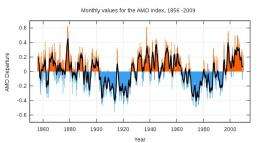April 5, 2012 report
Long term North Atlantic surface temperature fluctuations linked to aerosols

(PhysOrg.com) -- Manmade pollution doesn’t always cause atmospheric warming, a group of researchers from Britain’s Met Office Hadley Centre, write in their paper published in the journal Nature, sometimes it causes cooling. That’s because, they say, manmade aerosols injected into the atmosphere can cause heat from the sun to be reflected back into space. The team has made this observation after studying the impact of aerosols on the temperature of the air just above the surface of the North Atlantic over the past century and a half, which has a decades-long cycle of rising and lowering.
The cycle, which researchers refer to as the Multidecadal Atlantic Oscillation (MAO), is not due to natural causes the team asserts, as has been the common consensus, but to aerosols, both manmade and natural. They found this out by creating a climate model that included the effects of aerosols on air temperatures. In so doing, they were able to show that aerosols could be linked to seventy six percent of temperature variations found for the period 1850 to 2005. To demonstrate that their model was accurate, the team reduced the amount of aerosols in the simulation by roughly the same amount that has occurred in the real world due to legislation in most of the industrialized world since the 1970’s, and found that the temperature rise predicted by their model matched those that actually occurred. Thus, they say, the up and down temperature fluctuations over the surface of the North Atlantic over the past hundred and fifty five years, can be at least partially attributable to manmade pollution.
The team got the idea to look into the MAO after noting that it didn’t occur in other oceans, leading them to believe the source was manmade pollutants, because the time frame coincided with the industrial revolution. Subsequent analysis of surface temperatures over the Indian Ocean in more recent years indicates the same situation might be occurring there as has happened over the Atlantic due to increased aerosols from newly industrializing nations. Thus far, the Pacific seems unaffected by such aerosols, though the researches cannot explain why, as aerosols from China should be having an impact.
In a corollary to their studies the team suggests that the fluctuations in surface temperatures over the Atlantic likely have had an impact on weather related phenomenon, such as causing draughts in Africa, and more lately, giving rise to more severe hurricanes moving easterly towards the Americas.
More information: Aerosols implicated as a prime driver of twentieth-century North Atlantic climate variability, Nature (2012) doi:10.1038/nature10946
Systematic climate shifts have been linked to multidecadal variability in observed sea surface temperatures in the North Atlantic Ocean. These links are extensive, influencing a range of climate processes such as hurricane activity and African Sahel and Amazonian droughts. The variability is distinct from historical global-mean temperature changes and is commonly attributed to natural ocean oscillations. A number of studies have provided evidence that aerosols can influence long-term changes in sea surface temperatures, but climate models have so far failed to reproduce these interactions and the role of aerosols in decadal variability remains unclear. Here we use a state-of-the-art Earth system climate model to show that aerosol emissions and periods of volcanic activity explain 76 per cent of the simulated multidecadal variance in detrended 1860–2005 North Atlantic sea surface temperatures. After 1950, simulated variability is within observational estimates; our estimates for 1910–1940 capture twice the warming of previous generation models but do not explain the entire observed trend. Other processes, such as ocean circulation, may also have contributed to variability in the early twentieth century. Mechanistically, we find that inclusion of aerosol–cloud microphysical effects, which were included in few previous multimodel ensembles, dominates the magnitude (80 per cent) and the spatial pattern of the total surface aerosol forcing in the North Atlantic. Our findings suggest that anthropogenic aerosol emissions influenced a range of societally important historical climate events such as peaks in hurricane activity and Sahel drought. Decadal-scale model predictions of regional Atlantic climate will probably be improved by incorporating aerosol–cloud microphysical interactions and estimates of future concentrations of aerosols, emissions of which are directly addressable by policy actions.
Journal information: Nature
© 2012 PhysOrg.com


















